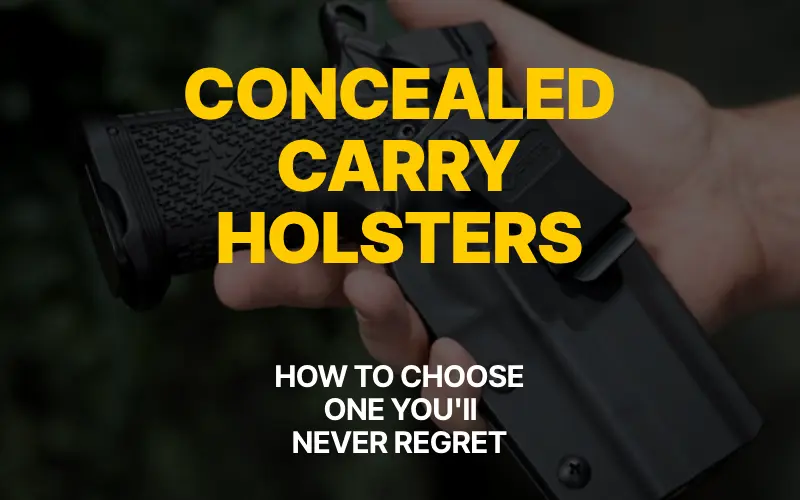It’s not uncommon to see new gun owners post pictures of their shiny new pistols online, asking for advice about mods and accessories. Most of the time, the response is pretty straightforward—ammo (so you can hit the range and train) and a good holster (to keep you and everyone else safe).
We’ve already put together a guide on choosing range ammo, which you can check out here.
Now, it’s time to talk holsters. This guide will walk you through picking the right holster based on your carry style, body type, and needs. Plus, we’ll discuss various types of holsters and break down what features you should look for to stay comfortable while keeping everything safe and efficient.
Types of Holsters
Standard options for CC
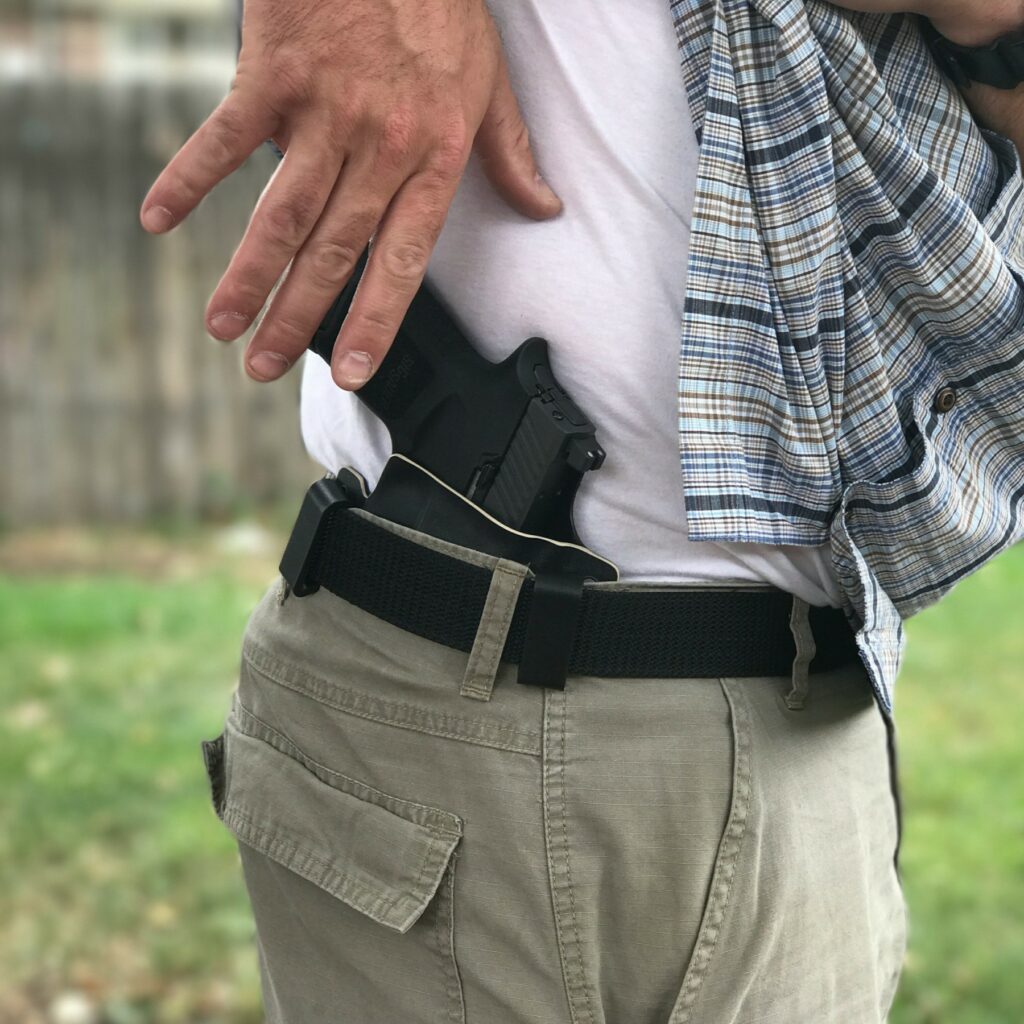
IWB Holsters
Good balance of concealment and accessibility. May feel more comfortable when seated.
IWB (inside the waistband) holsters sit snugly between your pants and your body, using your waistband and belt for support. Most IWB holsters clip on, making it easy to remove when you’re back home or driving for long time. Typically worn on the strong side (the same side as your dominant hand), usually placed between 3 o’clock to 5 o’clock (for right-handers).
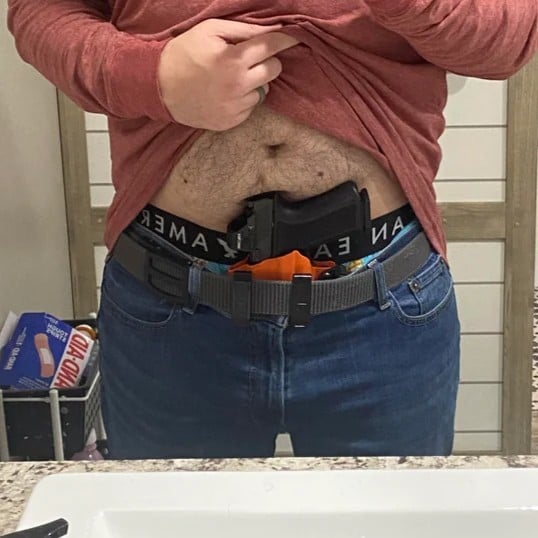
AIWB Holsters
Quicker access, better concealment, and easier draws while seated
With appendix carry, the firearm sits at the front of your body, anywhere from 12 o’clock to 2 o’clock for right-handed shooters. This style is gaining popularity for its convenience and gun accessibility. Also, they are easy for certain body types to conceal under fitted clothing. Comfortable appendix carry requires a quality holster, good belt, and pants with less tight waistband. A frequent reason not to carry AIWB is feeling uneasy about muzzle placement.
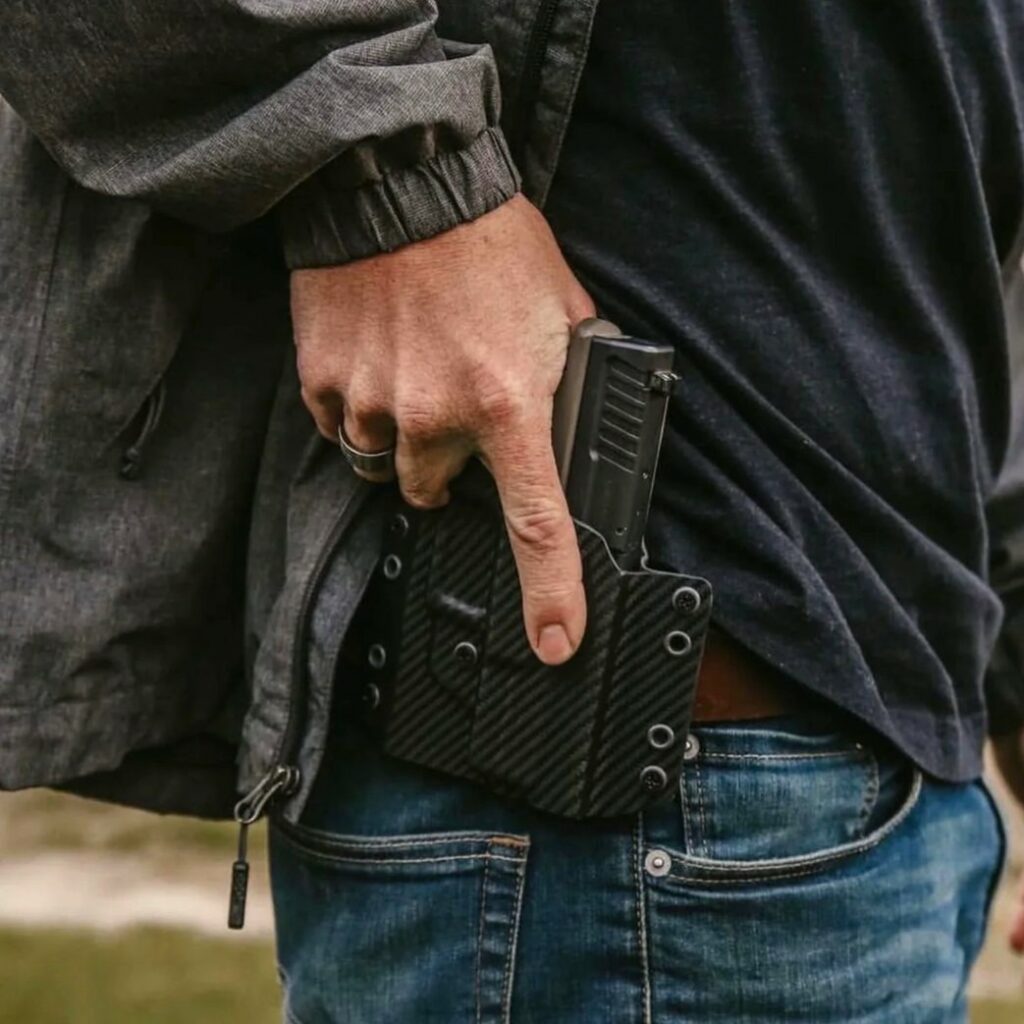
OWB Holsters
Most comfortable carry style, especially for bigger people; accommodates larger handguns.
OWB (outside the waistband) holsters attach outside your waistband, often on a belt. They’re popular for their comfort and quick draw but require extra effort to conceal—jackets or long shirts. They’re versatile and can work on either side of your body. Typically worn at 3 o’clock to 5 o’clock. On the downside, when carrying OWB, the grip may bulge when bending over or moving.
Paddle Holsters: A type of OWB holster with a unique design that keeps the firearm close to your body, reducing printing.
Specialty options for CC
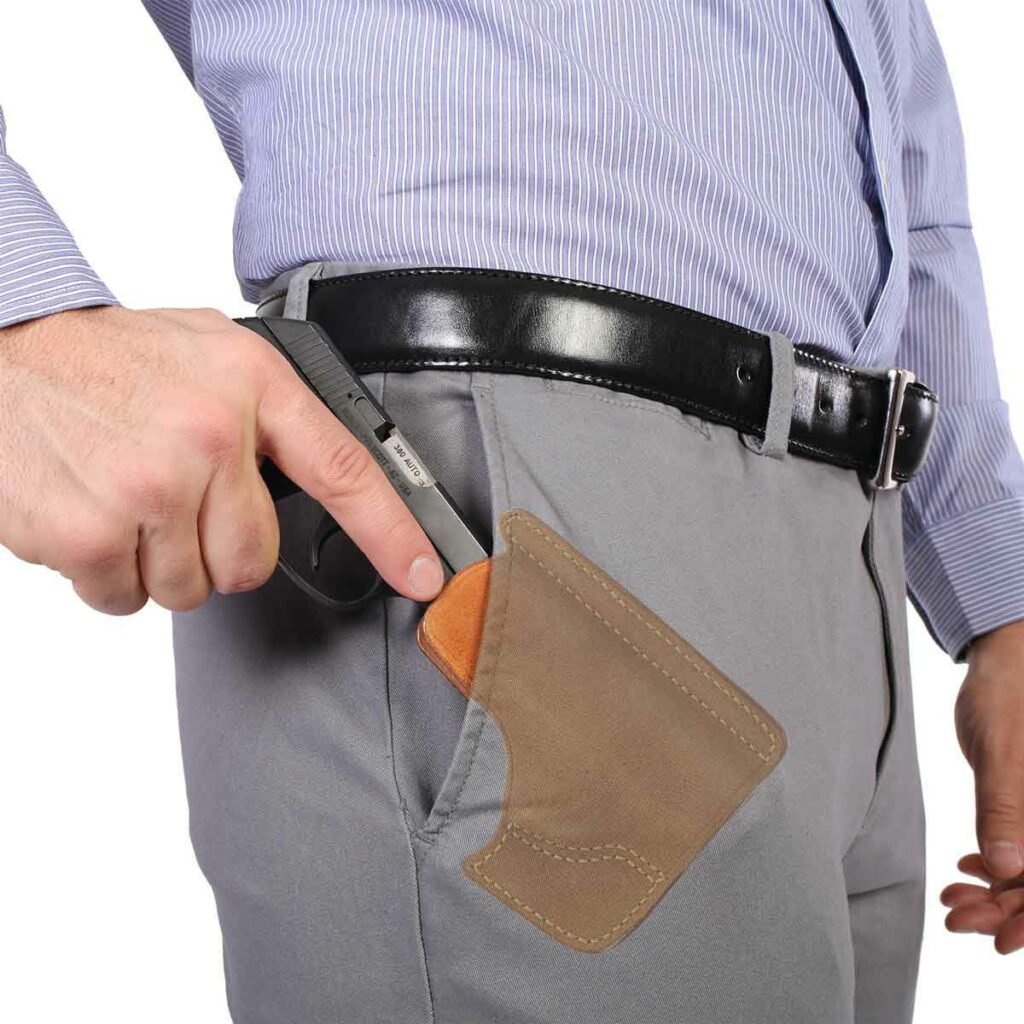
Pocket Holsters
Great for: Smaller guns and casual carry.
A pocket holster could be a good fit for a micro-compact pistol. These slide right into your pocket, offering trigger protection and reducing printing. They lack retention, though, so practice drawing with it to avoid fumbling. Look for pocket holsters that grip the inside of your pocket while staying smooth for your draw.
Do not put anything in the pocket where you keep your holstered pistol! These objects may interfere with the trigger.
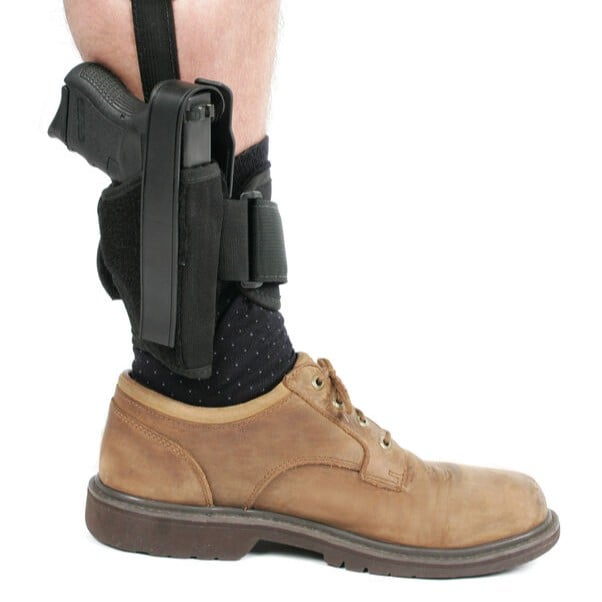
Ankle Holsters
Great for: Backup guns.
Ankle holsters strap a firearm to your leg, typically on your strong side. They’re discreet under pants but have a slower draw time—especially if you’re standing. While they’re handy for pulling a gun while seated, they’re best suited for carrying a secondary firearm, not a primary one.
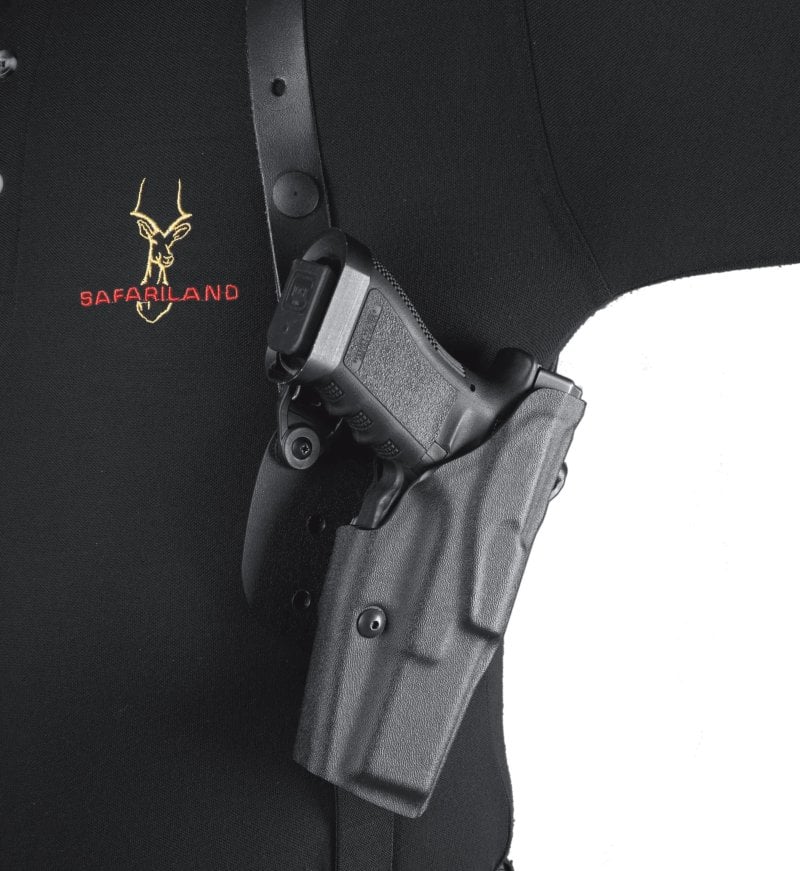
Shoulder Holsters
Great for: Dressy occasions. Driving.
Shoulder holsters hold the firearm under your arm, requiring a cross-body draw. This option is more of a specialty holster—good for those who wear suit jackets regularly. If this is your vibe, it’s worth a try but be prepared for specific wardrobe requirements.
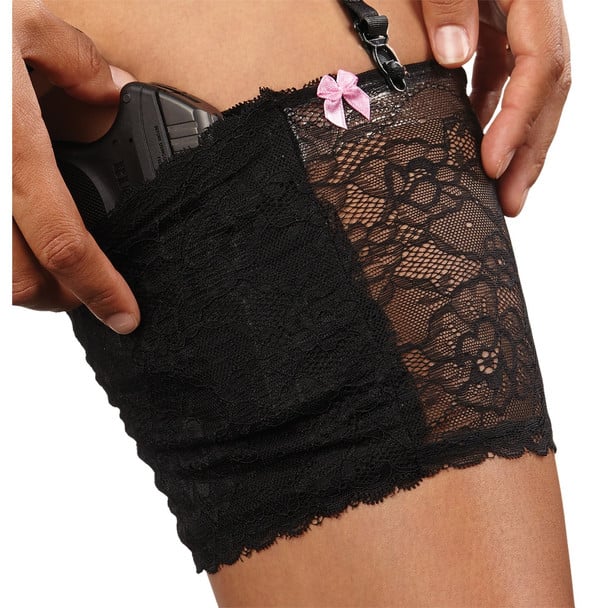
Thigh Holsters
Great for: Women wearing skirts or dresses.
Thigh holsters are niche but can work well for lightweight, compact guns under skirts or dresses. They’re not ideal for heavy firearms due to support issues, but they’re a practical secondary option for specific outfits.
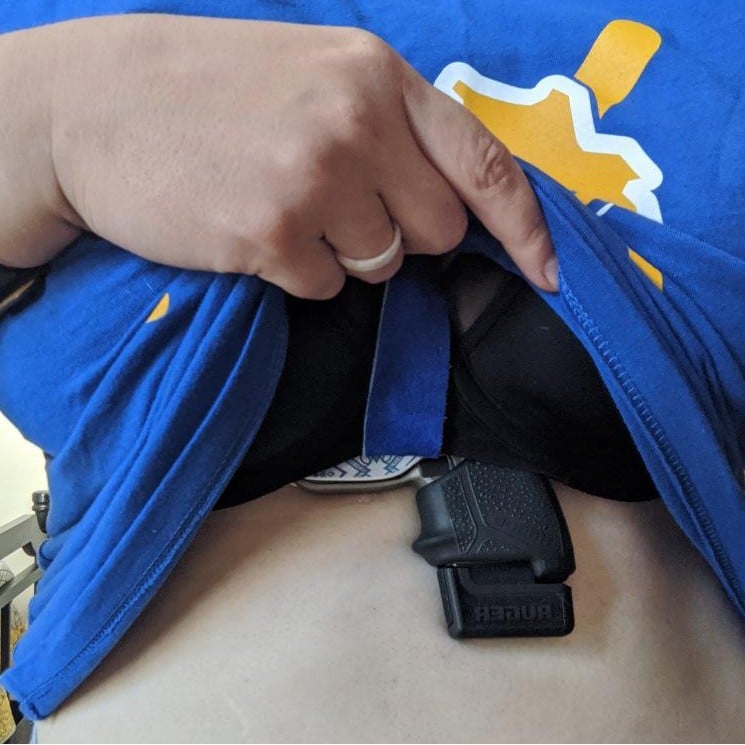
Apparel Holsters
Great for: Everyday casual wearers.
For those unsure about traditional holsters, apparel holsters—like bras or concealed carry shirts—offer alternatives. These are built into clothing, making carrying simple and discreet. However, certain designs (like bra holsters) may only accommodate light firearms. Accessibility may be limited and draw time may be slower with apparel holsters.
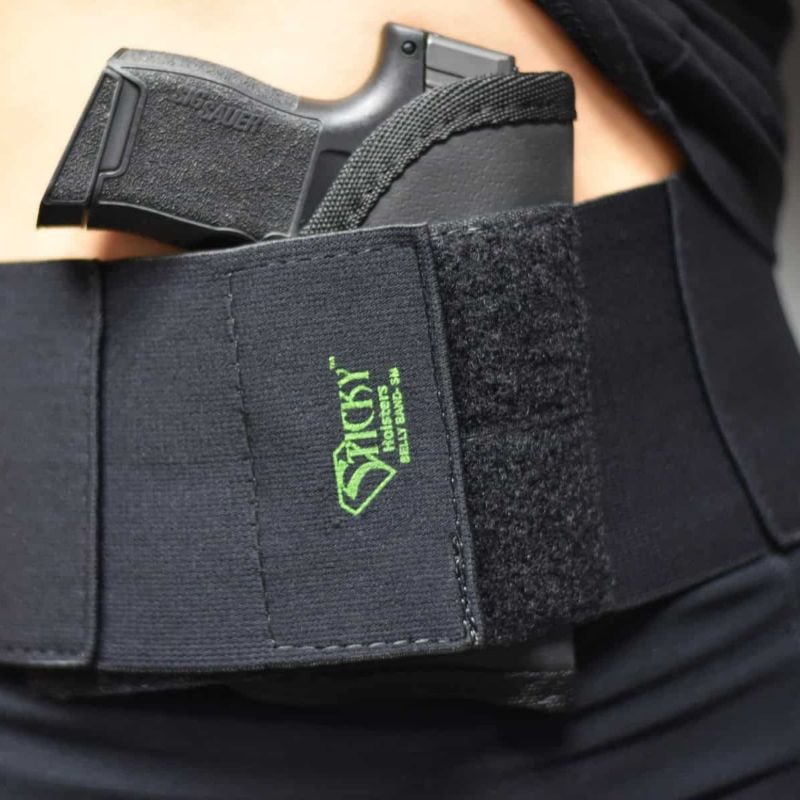
Belly Band Holsters
Great for: Athletes
These are stretchy bands that strap around your waist and have a built-in holster. They’re versatile and don’t rely on a belt. This holster style works great with gym clothes or outfits without belts. However, retention isn’t as sturdy as other holsters, and you can get hot and sweaty during extended wear.
Holster Materials
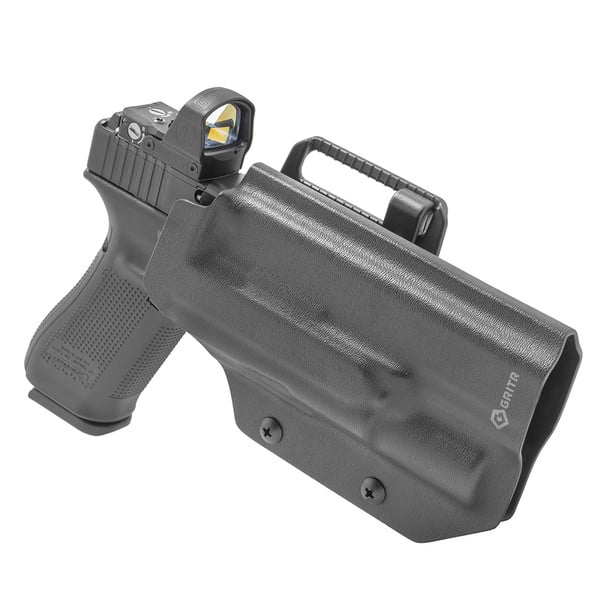
Kydex Holsters
Strongly recommended as a first holster.
- Retention: Kydex holsters are molded to fit your pistol perfectly.
- Durability: Kydex won’t soak up sweat, lose its shape, or wear out quickly. It’s waterproof and lightweight.
- Fast Draw: The rigid material makes your draw consistent and smooth every time.
Downsides:
- It’s not the most comfortable for all-day wear since it’s hard and doesn’t flex with your body.
- The hard plastic might scuff your firearm’s finish over time (though, honestly, leather does too).
- It can be noisy.
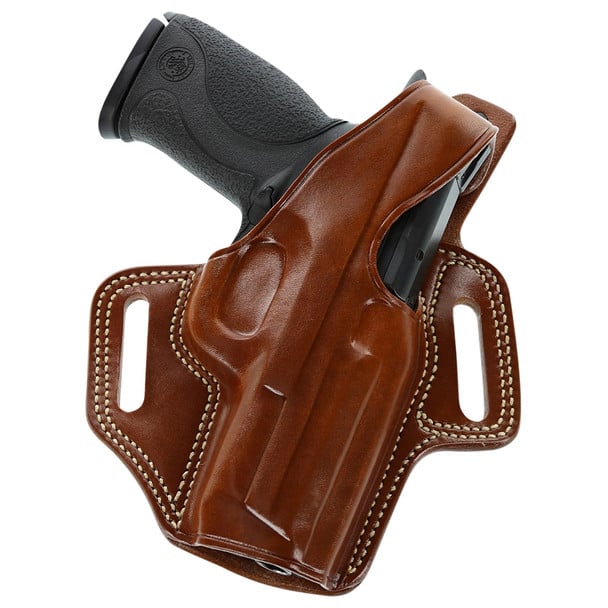
Leather Holsters
- Comfort: Leather naturally molds to your body over time, making it more comfortable to wear—especially if you carry all day..
- Timeless Appeal: They just look and feel classic.
Downsides:
- Retention isn’t as strong as Kydex. Over time, leather stretches, softens, and can loosen its hold on your gun.
- Leather requires maintenance. If not conditioned properly, it can dry out, crack, or even lose its shape. Water damage is also a potential issue.
- The wear is faster than Kydex.
Pro Tip: If you’re looking at leather, horsehide is tougher and more water-resistant than cowhide.
Pro Tip 2: Keep in mind leather holsters need a break-in period. Work the leather by bending it gently with your hands (don’t crease it!) or snapping the retention strap repeatedly. Avoid using conditioners like mink oil—they’ll make it too loose over time.
Hybrid Holsters
Hybrid holsters use Kydex for retention and leather or another soft material for comfort. The biggest downside boils down to the flexible backing. Over time, the sweatguard can fold over the back of your gun, making it harder to draw smoothly. Plus, reholstering while you’re wearing it can feel less secure because that flexibility doesn’t provide the structure you get from something like full Kydex.
Another concern is comfort—while some hybrids boast breathable material, it doesn’t always help much since it’s tucked between your pants and underwear, limiting airflow. And let’s not forget, hybrids can absorb sweat over time, making them harder to clean and prone to retaining odors.
So, while many people love brands like Crossbreed or Aliengear, we’d recommend sticking to pure leather or Kydex as a beginner.
Cheap Nylon
Stay away from cheap nylon “universal fit” holsters. They’re floppy, don’t provide proper trigger protection, and make drawing inconsistent. So don’t cheap out. Low-quality holsters (in any material, actually) will fail quickly or compromise safety.
Pro Tip: Pick your material based on how and where you carry. Kydex is excellent for strong retention and durability. Leather wins for comfort and casual carry.
Holster Features
Holster Retention
What Is Retention in a Holster?
Holster retention refers to how securely your holster holds your firearm and how easy (or difficult) it is to draw it. The type and level of retention matter because they directly impact both your safety and your reaction time. Too little retention could result in a loose gun, while too much can make it harder to access your weapon in a high-pressure situation.
Basically, it comes down to two types of retention:
Passive Retention (Level 1): This relies on tension or friction to hold your gun in place. It’s automatically engaged when you holster your firearm. Minimal security, but very quick to draw. Most concealed carry holsters fall into this category.
For Kydex holsters, you can typically adjust the retention with screws near the trigger guard. Avoid tightening so much that it impacts your ability to draw the firearm quickly and safely.
How to test passive retention of your holster:
- Place your UNLOADED gun in the holster.
- Hold the holster upside down over a bed.
- Shake it lightly—if the gun stays put, your retention is likely good for concealed carry.
Active Retention (Level 2 & Level 3): This includes manual mechanisms like thumb breaks, rotating hoods, or retention locks. You need to manually disengage these devices to draw the gun. While secure, they can slow down your draw speed if not practiced enough. Common for open carry and law enforcement.
Avoid holsters with poorly designed straps that impede a smooth, quick draw.
Examples of Retention Devices
- Thumb Break: A strap that snaps over the gun, released by pushing the snap button or lever with your thumb.
- Rotating Hood: A hood that flips over the top of the gun. You rotate it down to release the firearm.
- Retention Screws: Found on some passive holsters, these screws adjust the holster’s grip on the pistol, letting you fine-tune the retention to your preference.
- Active Locks: Like the Safariland ALS or Blackhawk Serpa systems, these “automatic” locking systems secure your weapon as soon as you holster it.
What Retention Level Do I Need?
When choosing your holster, ask yourself this key question: Do I prioritize security or speed? The level of retention should fit your specific situation:
Everyday Concealed Carry: If you’re carrying daily as a civilian, a Level 1 holster is likely your best bet. It’s simple and gives you fast access in an emergency.
Open Carry / Dangerous Environments: If you live or work in an area where open carry is allowed or your gun might be exposed to a grab attempt—a Level 2 holster is a good option. Level 3 holsters are mostly for LEOs.
Gun Belt and Holster Attachment
Get a Good Gun Belt for CC
Your standard department store belt just won’t cut it. Regular belts aren’t intended to support the weight of a handgun, so they’ll sag and shift under the pressure. This means your draw will be inconsistent and uncomfortable.
On the other hand, dedicated gun belts, whether made from leather or a composite material, are made to be both stiff and durable, ensuring that the weight of your firearm is evenly distributed.
When looking for a gun belt, consider these factors:
- Width: Most gun belts are 1.5 inches wide—perfect for everyday outfits.
- Material: Leather belts can look dressy, while nylon and composite belts are rugged and practical.
- Rigidity: The belt needs to be stiff enough to hold your holster and gun in place without sagging.
Consider Your CC Holster Attachment
A secure belt attachment system is key to keep your holster steady. Your holster should stay anchored to your waistband, ensuring the holster doesn’t come off or shift when you draw.
Loops: Considered the most secure belt attachment option. With loops, your belt runs directly through the attachment, anchoring your holster firmly in place. Common for OWB and some IWB.
Pros:
- Extremely secure
- Reduces shifting and movement
- Solid fit when matched to the right belt width
Cons:
- Can be less convenient—you’ll need to remove your belt to take the holster off if the loops aren’t snap-style.
Clips: Holster with clips are designed to clip over your belt or waistband, making them quick and easy to put on or take off. Usually used in IWB.
Pros:
- Convenient for daily carry
- Available in metal (durable) or plastic (lightweight) options
Cons:
- Poorly made clips may come off with your gun during a draw.
- Plastic clips can occasionally slip off, especially if you’re not using a proper gun belt.
Pick holsters with sturdy clips that have a good “underbite” (a curved catch at the bottom). Dual clips can add more stability.
Tuckable Hooks: For those who need to dress formally or tuck their shirt in, tuckable hooks are go-to. These attachments secure the holster to your belt while allowing you to tuck your shirt over the gun and holster.
Pros:
- Perfect for dress codes that require tucked-in shirts
- Offers decent concealment even in business attire
Cons:
- Slower draw than untucked configurations
- Generally less comfortable after an extended period
Make sure your belt and hook system can support the weight of your firearm.
Paddle: Paddle holsters feature a rigid paddle that slides between your pants and your body to hold the holster in place. While popular for easy on-and-off convenience, paddles are generally not recommended for serious concealed carry.
Pros:
- Very easy to wear and remove
- Works without a gun belt in some cases
Cons:
- Can be pulled off under force
- Typically only found on OWB holsters
Ride Height
Adjustable ride height refers to how high or low your firearm sits above your beltline. A grip that’s too high will stick out, making concealment difficult, while one that’s too low may make drawing awkward. The ideal ride should be high enough for an easy draw, but low enough to keep the gun aligned with your body.
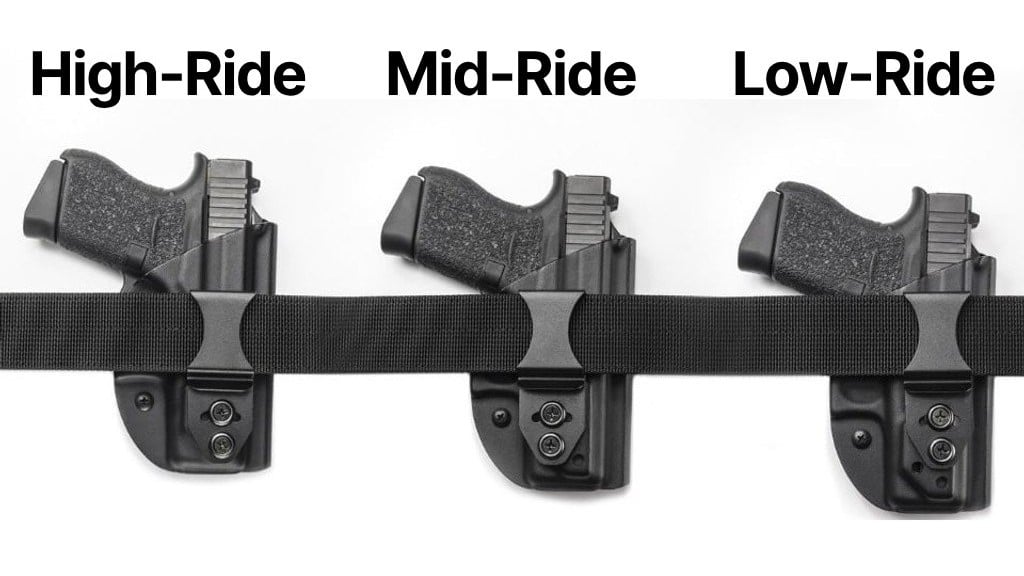
Mid-Ride Holster: Strikes the balance between concealment and ease of draw. It’s comfortable for sitting, driving, or walking around all day.
Best for: All-purpose carry like patrol work or daily CCW carry.
Adjustable Ride Height Holsters: Many holsters now allow you to tweak the ride height, giving you the flexibility to carry high, mid, or low depending on your activity, wardrobe, or personal preference.
Best for: Beginners figuring out their preferred height or anyone who needs adaptability for various scenarios.
Low-Ride Holster: Sit lower on your belt, with the butt of the gun just below the belt line. Offers deep concealment, reduces printing, and is quick to draw (close to your natural hand position). It’s also a favorite for women who prefer a lower position on the hips for better comfort and grip access.
- Best for: Deeper concealment or tactical setups
- Keep in mind: While excellent for standing and tactical work, low-ride holsters can get a bit uncomfortable when sitting for long periods, like in a car or at the dest.
High-Ride Holster: Sit higher, with the pistol’s grip above the belt line. Offers comfort and quick access.
- Best for: Those who have to sit for long periods since it keeps the barrel from digging into your body. Drawing and reholstering faster and easier.
Keep in mind: High-ride holsters can be a bit harder to conceal since the grip might print more through clothing.
Holser Cant
Cant is the forward tilt of a firearm in a holster. A slight cant helps tuck the gun’s grip closer to your body for better concealment.
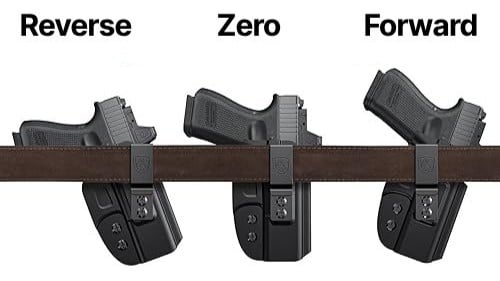
Neutral (Zero) Cant: Your holster sits vertically with no tilt. It’s straight up and down, which makes for a natural draw, especially in open carry at the 3 o’clock position. Not optimal for concealed carry since the grip tends to stick out and “print” through clothing.
Forward (Positive) Cant: The holster tilts forward, with your firearm’s grip angled away from your pelvis. This is the most common cant for concealed carry, especially at the 4 o’clock or kidney position. The well-known “FBI cant” (tilted forward at 10–20 degrees) allows your pistol to hug closer to your body, improving concealment and making for a smoother draw.
Reverse (Negative) Cant: Here, the holster tilts backward with the grip pointing toward your pelvis. This style is ideal for crossdraw or appendix carry because it aligns the grip of the gun with your natural draw motion while seated or reaching across your body.
Specialty Cant Configurations:
Shoulder Holster Cant: Depends on your handgun type. Snub-nose revolvers and micro-compact pistols can sit horizontally under your armpit. Larger guns (like full-size 1911s) are typically positioned vertically.
Ankle Holster Cant: A neutral cant often makes for the smoothest draw, but a forward cant might help the firearm conform more to your leg.
Small of Back (SOB) Cant: Neutral or slight negative cant positions work best. Horizontal cant is another option, where the gun rides flat along the beltline with the grip facing your strong side.
Sweat Guards
A sweat guard is an extra piece of material that extends upward from a holster to sit between your gun and your skin. Besides protecting your gun from sweat, it also makes carrying more comfortable by keeping sharp bits like the safety or hammer from digging into you. A good sweat guard should never interfere with your grip.
Concealment Wings & Pads
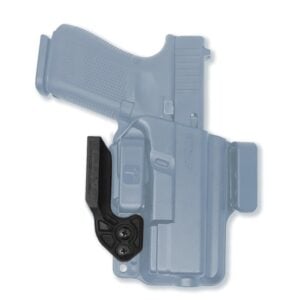
Holsters designed for IWB and appendix carry often feature “wings” or “wedge pads” that tilt the gun’s grip inward toward your body. This reduces printing and significantly improves concealment.
- Wings/Claws: A small attachment on the trigger side of the holster that uses belt pressure to push the gun inward.
- Pads/Wedges: Foam padding near the muzzle that angles the grip back toward your body.
FAQ about Holsters that you don’t want to skip
Carrying appendix might feel intimidating at first because the gun points toward sensitive areas. Don’t worry—proper safety measures and the right holster will eliminate these concerns. Start by choosing a quality holster that fully covers the trigger guard, has adjustable cant and ride height for comfort, and includes a wing/claw to keep the grip closer to your body for better concealment.
When practicing, always use an unloaded gun to get used to wearing the holster and test your comfort level. Adjust the placement (usually between 12 and 2 o’clock) until you find what feels right. Wear sturdy pants with a strong belt and slightly loose shirts for better concealment. And here’s a pro tip for safe reholstering—always remove the holster from your waistband first to avoid accidental missteps. If you’re nervous, start by carrying at home until you feel comfortable, and don’t hesitate to seek professional training.
Many folks choose AIWB carry over traditional IWB at 3 o’clock because it comes with some clear advantages. First off, it’s faster. Your hands don’t have to move as far to access your firearm, making it quicker to draw in most situations—whether you’re standing, seated in a car, or even in the middle of a scuffle. It also conceals better on most body types during daily activities, reducing the chances of printing or accidentally exposing your gun.
On top of that, AIWB offers easier control during close encounters. Whether you’re fighting off a gun grab or trying to defend yourself in tight quarters, having the gun in front makes it easier to protect. And for anyone wearing a seatbelt or sitting for long periods (like in a car or restaurant), accessing your firearm with AIWB generally requires less movement.
Absolutely! Carrying appendix-style for bigger guys is all about working with your body type. This just means positioning your holster properly—either above your gut or around the lower belly area. Avoid placing your holster directly on the belt line where both areas meet, as it causes discomfort when sitting or bending. For sitting, lifting your belt slightly and letting your gut provide some clearance makes things much easier.
To make this work, you’ll need three things: a quality, rigid belt, a comfortable and reliable holster, and a slightly looser belt fit to allow flexibility throughout the day. Whether you’re standing, walking, or sitting, these adjustments ensure that you can carry comfortably without any pinch points. And remember, always check your holster placement before reholstering to avoid mishaps.
It really depends on what works best for you and your daily routine. Some folks are fine with just the magazine in their gun, especially if it holds 10-15 rounds and they’re in a low-risk area.
Others like to carry one spare mag—it’s a solid middle ground in case you need more rounds. If you’ve got a smaller-capacity gun (like one with 6-8 rounds) or spend time in higher-risk areas, you might want to carry two or more mags.
First things first, invest in a solid gun belt. Don’t like heavy-duty belts? You can give UltiClips a try. They work with dress belts and even sweats and no belt at all. Pair your belt with a good kydex holster.
If comfort is still an issue, consider adding a foam wedge to the back of your holster. It feels better against your body and helps reduce printing by tucking the grip closer. Some people also prefer wearing a tucked-in undershirt to keep the holster from rubbing directly against their skin.
For a concealed carry holster, a thumb break retention isn’t usually necessary. IWB holsters already have enough passive retention to keep your firearm secure. A thumb break can add extra bulk, slow down your draw, and give you another step to manage in a high-stress situation. But if you train with it enough, it’ll eventually feel natural and not really slow you down much.
Where a thumb break might help is if your weapon gets exposed during a struggle and someone tries to grab it. Otherwise, with your firearm concealed, you typically don’t have to worry about people grabbing at it. Some folks like having a thumb break because it’s what was available for their particular setup—others stick with passive retention alone and are just fine.
A lot of discomfort comes down to choosing the wrong holster. If it’s cheap, poorly made, or doesn’t suit your body type or firearm, you’re setting yourself up for trouble. Always go for quality—it’s worth the investment.
Positioning is another big factor. Everyone’s body is different, so copying where someone else carries might not work for you. The holster could be sitting too high or too low on your belt, or the angle might not match your natural draw. Take some time to experiment with positioning—adjust the height, cant (angle), and placement until it feels right.
If you’re driving, an appendix carry is a solid choice due to faster access and draw—just tuck your shirt behind the grip for easier access. For some body shapes, an IWB holster might feel more comfortable, but drawing from 4:00-5:00 can be harder. Another good option is a tactical shoulder holster since it keeps your firearm in a comfortable, accessible position while seated.
Wearing a concealed carry holster in hot weather can be tricky, but it’s manageable with the right setup and some wardrobe tweaks. If you carry IWB at 3-5 o’clock, try a holster with a slight forward cant and adjust the ride height as high as possible for better concealment. Dark-colored or patterned shirts work best to minimize printing, while white and athletic fabrics tend to show the outline of your gun more clearly. Just know most people won’t notice if your gun is printing a little—if they see anything, they’ll likely assume it’s a phone or some other gadget.
If you’re finding it hard to conceal on your side, consider trying an appendix carry setup. It’s often easier to conceal because it sits flat against your body, especially with a good holster with a claw or pad. Some folks like adding a wicking undershirt to handle the heat and keep sweat off the holster, pairing it with a looser or untucked button-up shirt.
Quick Tips for Choosing the Perfect Concealed Carry Holster
Trigger Protection is Non-Negotiable
Your holster MUST completely cover and protect the trigger guard to avoid accidental trigger manipulation. Exposed triggers risk snagging on clothes or objects—always choose rigid, well-fitted holsters.
Pro tip: Skip any holster with trigger finger-operated buttons or levers that can cause accidental misfires during the draw.
Comfort Matters for Everyday Carry
If it’s not comfortable, you won’t wear it. Materials, padding, and proper fit against your body can make all the difference. Experiment with positioning and adjustments for the perfect carry. To make it even more comfortable, consider adding neoprene padding and using a quality gun belt.
Holsterability = Safety
You should be able to draw and re-holster your firearm with one hand. After drawing, the holster’s opening should remain rigid, keeping it in position so you don’t struggle to put the gun back. Flexible, collapsing holsters can create unsafe habits and may put your supporting hand in the line of fire while re-holstering.
Strong Side vs. Weak Side
Strong side holsters are located on your shooting hand side, allowing quick and efficient draw. Crossdraw or weak side holsters, while less ideal for most, may better suit seated users or specific carry needs. Choose a position that fits your lifestyle and offers fast access.
On-Body Beats Off-Body Carry
A concealed firearm stays safest on your person. Off-body options, like bags or purses, pose theft risks and slow your draw time. Stick to on-body carrying unless absolutely necessary.
Maintenance is Key for Long-Term Performance
Keep your leather holster in good shape with regular cleaning and inspections. Look for loose stitching, damage, or moisture buildup—these can compromise safety and usability. Store your holster in a cool, dry place when not in use. Inspect your Kydex holster for cracks and loose parts.
Consider Special Features for Women’s Carry Needs
Women should look for holsters that account for their curves and clothing styles. Look for holsters with adjustable features for a tailored fit and designs that suit both form-fitting and layered outfits.
Try Before You Buy
Test different holsters, carry positions, and adjustments until you find one that’s comfortable for extended wear. A holster that works well for someone else might not work for you—personal preference is paramount here.
